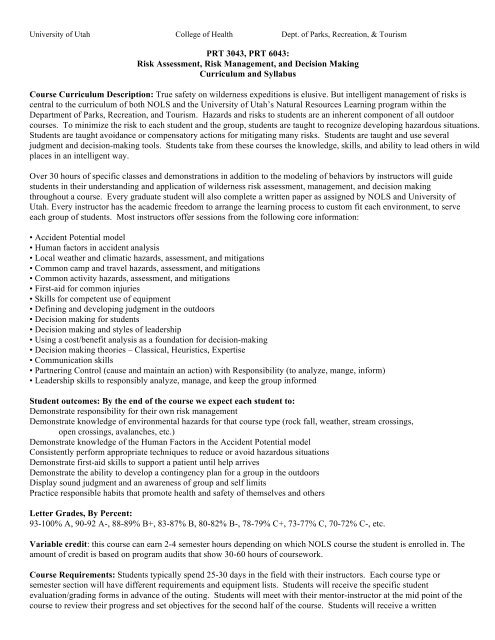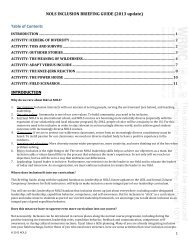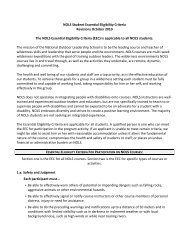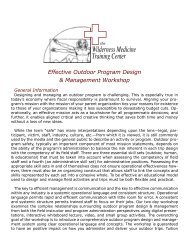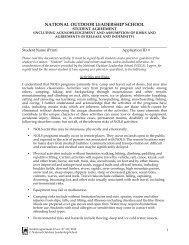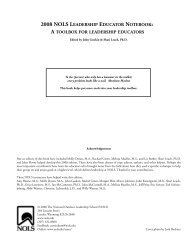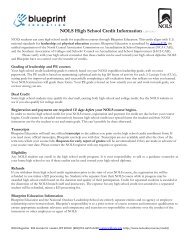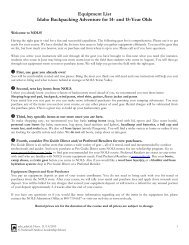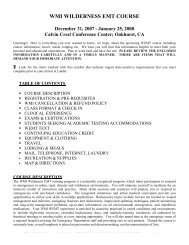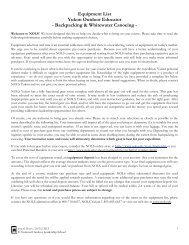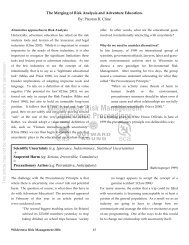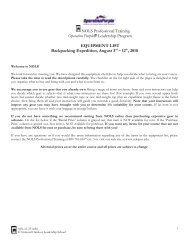Risk Assessment, Risk Management, and Decision Making - NOLS
Risk Assessment, Risk Management, and Decision Making - NOLS
Risk Assessment, Risk Management, and Decision Making - NOLS
- No tags were found...
You also want an ePaper? Increase the reach of your titles
YUMPU automatically turns print PDFs into web optimized ePapers that Google loves.
University of Utah College of Health Dept. of Parks, Recreation, & TourismPRT 3043, PRT 6043:<strong>Risk</strong> <strong>Assessment</strong>, <strong>Risk</strong> <strong>Management</strong>, <strong>and</strong> <strong>Decision</strong> <strong>Making</strong>Curriculum <strong>and</strong> SyllabusCourse Curriculum Description: True safety on wilderness expeditions is elusive. But intelligent management of risks iscentral to the curriculum of both <strong>NOLS</strong> <strong>and</strong> the University of Utah’s Natural Resources Learning program within theDepartment of Parks, Recreation, <strong>and</strong> Tourism. Hazards <strong>and</strong> risks to students are an inherent component of all outdoorcourses. To minimize the risk to each student <strong>and</strong> the group, students are taught to recognize developing hazardous situations.Students are taught avoidance or compensatory actions for mitigating many risks. Students are taught <strong>and</strong> use severaljudgment <strong>and</strong> decision-making tools. Students take from these courses the knowledge, skills, <strong>and</strong> ability to lead others in wildplaces in an intelligent way.Over 30 hours of specific classes <strong>and</strong> demonstrations in addition to the modeling of behaviors by instructors will guidestudents in their underst<strong>and</strong>ing <strong>and</strong> application of wilderness risk assessment, management, <strong>and</strong> decision makingthroughout a course. Every graduate student will also complete a written paper as assigned by <strong>NOLS</strong> <strong>and</strong> University ofUtah. Every instructor has the academic freedom to arrange the learning process to custom fit each environment, to serveeach group of students. Most instructors offer sessions from the following core information:• Accident Potential model• Human factors in accident analysis• Local weather <strong>and</strong> climatic hazards, assessment, <strong>and</strong> mitigations• Common camp <strong>and</strong> travel hazards, assessment, <strong>and</strong> mitigations• Common activity hazards, assessment, <strong>and</strong> mitigations• First-aid for common injuries• Skills for competent use of equipment• Defining <strong>and</strong> developing judgment in the outdoors• <strong>Decision</strong> making for students• <strong>Decision</strong> making <strong>and</strong> styles of leadership• Using a cost/benefit analysis as a foundation for decision-making• <strong>Decision</strong> making theories – Classical, Heuristics, Expertise• Communication skills• Partnering Control (cause <strong>and</strong> maintain an action) with Responsibility (to analyze, mange, inform)• Leadership skills to responsibly analyze, manage, <strong>and</strong> keep the group informedStudent outcomes: By the end of the course we expect each student to:Demonstrate responsibility for their own risk managementDemonstrate knowledge of environmental hazards for that course type (rock fall, weather, stream crossings,open crossings, avalanches, etc.)Demonstrate knowledge of the Human Factors in the Accident Potential modelConsistently perform appropriate techniques to reduce or avoid hazardous situationsDemonstrate first-aid skills to support a patient until help arrivesDemonstrate the ability to develop a contingency plan for a group in the outdoorsDisplay sound judgment <strong>and</strong> an awareness of group <strong>and</strong> self limitsPractice responsible habits that promote health <strong>and</strong> safety of themselves <strong>and</strong> othersLetter Grades, By Percent:93-100% A, 90-92 A-, 88-89% B+, 83-87% B, 80-82% B-, 78-79% C+, 73-77% C, 70-72% C-, etc.Variable credit: this course can earn 2-4 semester hours depending on which <strong>NOLS</strong> course the student is enrolled in. Theamount of credit is based on program audits that show 30-60 hours of coursework.Course Requirements: Students typically spend 25-30 days in the field with their instructors. Each course type orsemester section will have different requirements <strong>and</strong> equipment lists. Students will receive the specific studentevaluation/grading forms in advance of the outing. Students will meet with their mentor-instructor at the mid point of thecourse to review their progress <strong>and</strong> set objectives for the second half of the course. Students will receive a written
University of Utah College of Health Dept. of Parks, Recreation, & Tourismevaluation <strong>and</strong> grading form by the end of the course. Students must successfully complete the course <strong>and</strong> earn the gradeaccording to their evaluation.PRT 6043 Graduate CreditEligible students: College baccalaureate graduates who register in advance.The University of Utah grade will be composed of:1. 80%, the <strong>NOLS</strong> instructor’s written <strong>and</strong> numerical evaluation of the student at the successful completionof their <strong>NOLS</strong> course or semester, converted to the University of Utah grade point system.2. 20%, the student’s grade on a written paper, as graded by a PRT faculty member.The paper will be:- Follow the topic guidelines as described for each specific course number (a sheet separate from this page).- At least 10 st<strong>and</strong>ard pages in length, word-processed or typed with double spacing <strong>and</strong> a 10 or 12 point font.- Evaluated according to its logic, organization, grammatical construction, <strong>and</strong> support (references).- Written in a format used by scholarly journals in the student's discipline. APA format is preferred; if written in another format, theidentity of the format must be stated.- The paper should be mailed or faxed within 4 weeks of <strong>NOLS</strong> course completion date to the Admission office of <strong>NOLS</strong>. It will beforwarded <strong>and</strong> evaluated by graduate faculty, <strong>and</strong> a grade submitted to the <strong>NOLS</strong> office.Domain specific Text Resources:Canoeing <strong>and</strong> Kayaking – Instruction Manual (1987) Gullion, L.Fundamentals of Kayak Navigation (1993) Burch, D.Learning to Rock Climb (1981) Loughman, M.Mountaineering: The freedom of the hills (1992) Graydon, D.<strong>NOLS</strong> Climbing Instructor Notebook (1997) ed. Powers, P.<strong>NOLS</strong> Leadership Toolbox (2001) ed. Gookin, Doran, <strong>and</strong> Green<strong>NOLS</strong> Mexico Sailing Instructor Notebook (1997) ed. Sickle <strong>and</strong> Burke<strong>NOLS</strong> Sea Kayaking Instructor Notebook (1997) ed. Conlan <strong>and</strong> Peabody<strong>NOLS</strong> Wilderness Educators’ Notebook (1999) ed. Gookin<strong>NOLS</strong> Wilderness First Aid (2000) Schimelpfenig <strong>and</strong> Lindsey<strong>NOLS</strong> Wilderness Mountaineering (1993) Powers, P.River Rescue: A manual for whitewater safety (1997) Bechdel <strong>and</strong> RaySea Kayaking: A manual for long-distance touring (1988) Dowd, J.The Complete Whitewater Rafter (1996) Bennett, J.The National Outdoor Leadership School’s Wilderness Guide (1999) Harvey, M.Wilderness Educator’s Notebook (1999) Ed. Gookin, J.Note: This syllabus has been created as a guide to the class <strong>and</strong> is as accurate as possible. However, all information issubject to change as the semester progresses. Any changes will be discussed during class <strong>and</strong> will be documented inwriting. It is your responsibility to keep track of any changes.Curriculum Contacts:<strong>NOLS</strong>: John Gookin,Univ. of Utah: Kirk Nichols


